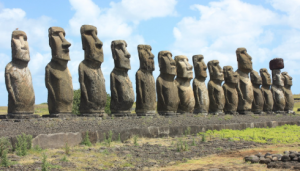The prehistoric collapse of Easter Island’s monument-building society did not occur as long thought, according to a fresh look at evidence by researchers at four institutions.
“The general thinking has been that the society that Europeans saw when they first showed up was one that had collapsed,” said Robert J. DiNapoli, a doctoral candidate in the University of Oregon’s Department of Anthropology who led the analysis. “Our conclusion is that monument-building and investment were still important parts of their lives when these visitors arrived.”
Easter Island, a Chilean territory also known as Rapa Nui, is located about 3,000 kilometers (1,864 miles) from South America and 2,000 kilometers (1,242 miles) from any other inhabited island.
Rapa Nui is believed to have been settled in the 13th century by Polynesian seafarers. They soon began building massive stone platforms stacked with megalithic statues and large, cylindrical stone hats that were used for cultural and religious rituals, including burial and cremation. A widely-held narrative is that monument construction stopped around 1600 after a major societal collapse.
Read more: archaeology news network
Ask me anything
Explore related questions





